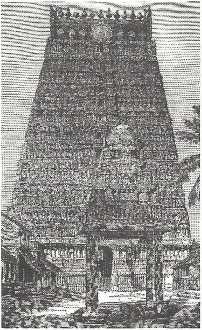Gopura
By Swami Harshananda
Gopura literally means ‘that which protects the town or city’.
A gopura is any high structure from where representatives of the armed forces can keep a watch over the movements of men and materials that may prove harmful to the society or the country.
Gradually in common parlance it got associated with the towers built over the temples. Gopura were built both on the sanctum and on the outer walls. The tower over the sanctum is generally small in size. They are called ‘vimāna’. The tower on the outer walls were usually of gigantic proportions. They are termed as ‘gopura’.
It is generally constructed with a stone base and the superstructure of brick and mortar. It is rectangular in shape. The exterior walls are covered with sculpture of stucco.
The various storeys of the gopura are similar but the sizes and dimensions become gradually smaller. The top is shaped like a semi-circular drum and is capped with kalaśas or finials which may be 3 or 5 or 7 or 9.
Types of Gopura[edit]
According to the architectural treatises like the Mānasāra, gopura-s are of ten types. They can have sixteen or seventeen storeys. Gopuras are built at the main entrances of temples. In the big temples, they can be situated in all the four directions if a high wall is surrounding them. Temple gopuras are generally of three types:
- Nāgara - curvilinear tower
- Drāviḍa - the form of a truncated pyramid
- Vesara - combines the features of both the styles above
Significant Gopura[edit]
The gopuras of some temples in South India are noteworthy. They are situated at:
- Tiruccirapalli
- Cidambaram
- Śrīraṅgam
- Tañjāvur
- Kāñcīpuram
- Madurai[1]
- Hampi[2]
References[edit]
- The Concise Encyclopedia of Hinduism, Swami Harshananda, Ram Krishna Math, Bangalore

